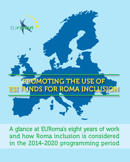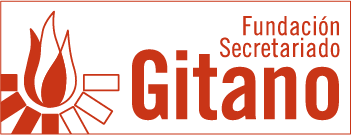Promoting the Use of ESI Funds for Roma Inclusion [editar]
A glance at EURoma’s eight years of work and how Roma inclusion is considered in the 2014-2020 programming period
Author EURoma
Bibliographic references EURoma (2016). Promoting the Use of ESI Funds for Roma Inclusion. Madrid . EURoma
Publisher EURoma
Year 2016
Place of publication Madrid
Collection FSG as contributing author
Themes International Social Inclusion
Tags

The Report ‘Promoting the Use of ESI Funds for Roma Inclusion. A glance at EURoma’s eight years of work and how Roma inclusion is considered in the 2014-2020 programming period’ has been elaborated in the context of the European Network on Social Inclusion and Roma under the Structural Funds (EURoma Network).
Led by the Spanish ESF Managing Authority (Ministry of Employment and Social Security), the Network aims to promote the use of Structural Funds for the inclusion of the Roma population and as a result enhancing the effectiveness of policies targeting the Roma community. To this end, it gathers public bodies responsible for Structural Funds (notably ESF Managing Authorities or delegated Intermediate Bodies/Implementing Authorities) and for the policies targeting the Roma population (notably the National Roma Contact Points) from fifteen Member States: Austria, Belgium, Bulgaria, Croatia, Czech Republic, Finland, Greece, Hungary, Italy, Poland, Portugal, Romania, Spain, Slovakia and Sweden. The Network Technical Secretariat is hosted by the Fundación Secretariado Gitano (FSG).
About the Report
During its eight years of activity, EURoma has produced a number of documents aimed to improve the use of Structural Funds for Roma inclusion. This report is the last Network publication in the 2007-2013 programming period. It has a twofold objective:
- To provide a glance at EURoma’s trajectory, main products and overall added value and impact during its eight years of operation.
- To review how fourteen countries currently involved in the Network (Austria, Belgium, Bulgaria, Croatia, Czech Republic, Greece, Hungary, Italy, Poland, Portugal, Romania, Slovakia, Spain and Sweden) consider Roma inclusion in the Operational Programmes adopted for the 2014-2020 European Structural and Investment (ESI) Funds programming period, identifying the most relevant trends as well as the key challenges for the implementation phase that has recently started.
It is expected that the mutual learning and common reflection on crucial aspects for the implementation of the funds, including the potential challenges, at an early stage help better address them throughout the 2014-2020 period and therefore contribute to achieving the most efficient use of the ESI Funds for the inclusion of vulnerable groups, including Roma.
Additional documents
- EURoma Report 'Promoting the Use of ESI Funds for Roma Inclusion. A glance at EURoma’s eight years of work and how Roma inclusion is considered in the 2014-2020 programming period’- Full report
- EURoma Report 'Promoting the Use of ESI Funds for Roma Inclusion. A glance at EURoma’s eight years of work and how Roma inclusion is considered in the 2014-2020 programming period’- Online version
- EURoma Report 'Promoting the Use of ESI Funds for Roma Inclusion. A glance at EURoma’s eight years of work and how Roma inclusion is considered in the 2014-2020 programming period’- Short version English
- Informe EURoma 'Promoviendo el uso de los Fondos EIE para la inclusión de la población gitana. Un repaso a los ocho años de trabajo de EURoma y a cómo está considerada la inclusión de la población gitana en el periodo de programación 2014-2020’- Short version Spanish

